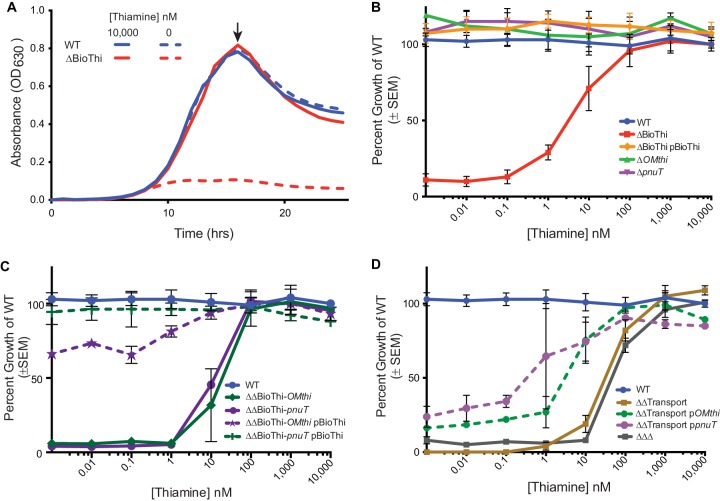FIG 2 .
Growth phenotypes of B. thetaiotaomicron thiamine acquisition mutants. Thiamine acquisition operons have differential effects on the ability of B. thetaiotaomicron to grow under thiamine-limiting conditions. (A) Representative growth curve of the wild-type (WT) and ΔBioThi strains showing growth defects of the ΔBioThi mutant in a thiamine-deficient environment (0 nM) and a thiamine-replete environment (10,000 nM). An arrow indicates the maximal growth point at ~17.5 h used to calculate the percentage of growth of the WT in minimal medium supplemented with 10,000 nM thiamine to compare growth phenotypes across concentrations of thiamine in panels B to D. (B) Single mutants with mutation of the outer membrane transporter (ΔOMthi) and inner membrane transporter (ΔpnuT) loci showed no defect, while ΔBioThi strains were variably attenuated in thiamine concentrations of <100 nM, and complementation of ΔBioThi with the entire loci with the native promoter expressed in trans can fully complement the mutant. (C) Mutants lacking biosynthesis (ΔBioThi) and a single transport gene (pnuT or OMthi) have severe growth phenotypes at <100 nM thiamine but can be complemented with the biosynthesis locus under its native promoter to wild-type or near-wild-type levels. (D) The double transport mutant (ΔΔTransport) and triple locus mutant (ΔΔΔ) were both highly attenuated in thiamine concentrations of <1,000 nM. Complementation of single transporters in the ΔΔTransport background can partially rescue the severe growth phenotype. SEM, standard error of the mean.

